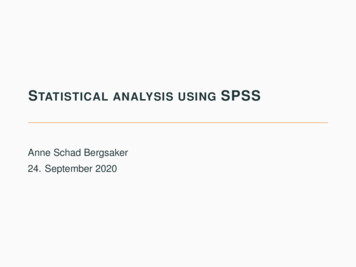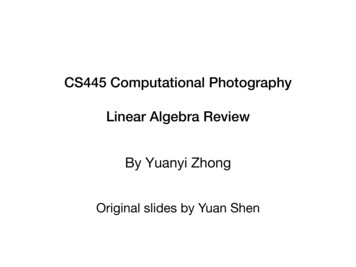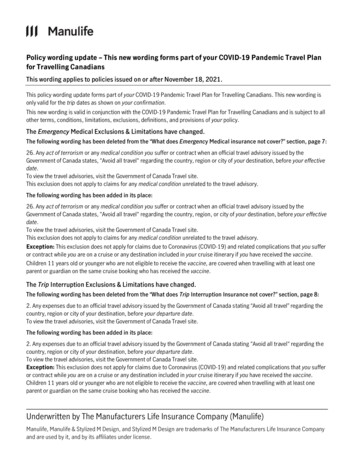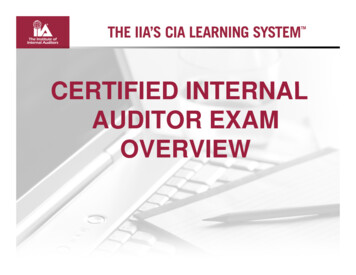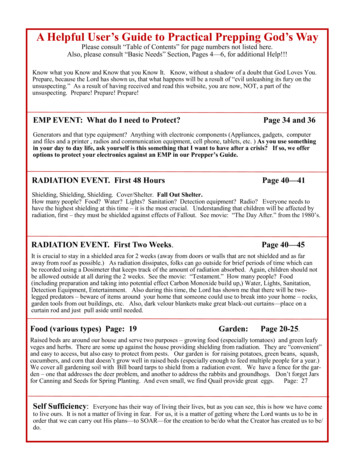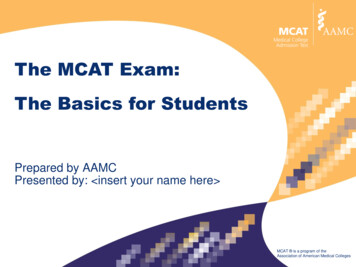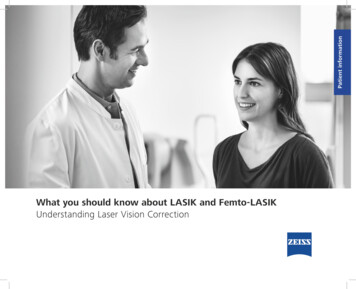
Transcription
Patient informationWhat you should know about LASIK and Femto-LASIKUnderstanding Laser Vision Correction
The strong desire to see clearlyLaser Vision Correction with a proven procedureSharp vision is something everyone desires. Not all of us, however, havegood eyesight. Eye conditions such as nearsightedness, farsightedness andastigmatism, so-called refractive errors, are very common.Over half the world’s population relies on eyeglasses or contact lenses tosee well. For many people, they are a suitable solution. Others consider theman inconvenience that interferes with their daily lives. They want to enjoy goodvision without needing to wear glasses or contacts.Today, most refractive errors can be effectively treated with Laser VisionCorrection. LASIK, and its advanced form Femto-LASIK are verywidely performed procedures.Whether Laser Vision Correction is right for you, depends on various factors.Consult your eye doctor to determine the best option for your vision needs.3
How the eye worksUnderstanding visionThe human eye is truly remarkable in its design.Each eye is unique. Each eye condition is alsounique. Vision quality is largely determined bythe size and shape of our eyes.With a healthy eye, light rays entering the eyeare focused directly on the retina to form asharp image, which is then sent to the brain viathe optic nerve, resulting in a visual image.When the eye’s dimensions are not well-aligned,the light rays are not correctly focused. This resultsin a refractive error such as nearsightedness,farsightedness and astigmatism (an irregularcurvature of the cornea). Refractive errors arevery widespread and affect people of all ages.LensRetinaLight raysNormal visionWith normal vision, the eye’sdimensions are well-aligned. Lightrays are focused directly on theretina to create a clear image.4PupilCorneaOptic nerve
Common vision disordersRefractive errorsRefractive errors occur when the curvature of the cornea, the main determining factor of refractive power, is notaligned with the length of the eye. As a result, the light rays are prevented from focusing directly on the retina.Nearsightedness (myopia)When the eyeball is too long, thelight rays are focused in front ofthe retina. Distant objects appearblurry, those up close are clear.Light rays are focusedin front of the retinaFarsightedness (hyperopia)When the eyeball is too short,the light rays are focused behindthe retina. Nearby objects appearblurry, distant ones are clear.Light rays are focusedbehind the retinaAstigmatismThe cornea’s irregular shape causeslight rays to focus on more thanone point. Overall vision appearsblurry or distorted.Light rays are focused infront of and behind the retina5
A widely practiced surgeryCharacteristics of LASIK and Femto-LASIKSince its introduction in the early 1990s, laser-assisted in-situ keratomileusis, or LASIK for short, hasbecome the most widely performed laser treatment method for correcting refractive errors.At a glance Generally quick visual recovery Most frequently performed procedure Treatment standard for more than 20 years Widely available and performed by many surgeons Femto-LASIK: the entire procedure is donewith lasers onlyWith LASIK, a flap is created and folded back.6
7
Comparing the two proven proceduresTreatment steps of LASIK and Femto-LASIKSTEP 1Preparing the treatmentA microkeratome is positionedin preparation of the flap cut.With traditional LASIK, a controlled blade(microkeratome) is used to create the flap (a kindof hinged piece of corneal tissue). With advancedbladeless Femto-LASIK, a highly precise flap isquickly created with a femtosecond laser.Prior to treatmentAnesthetic eye drops are applied to the eye. Aneyelid holder prevents the eye from blinking duringthe procedure.LASIKFemto-LASIKScan the QR code to see how theprocedure is performed.www.zeiss.com/LASIK-treatment8Creating the flapA flap is created with a highlyprecise femtosecond laser.
STEP 2STEP 3STEP 4STEP 5Creating the flapThe microkeratome creates aflap, a hinged corneal pieceof tissue.Folding back the flapThe flap is gently foldedback, exposing the innercorneal tissue to be treated.Correcting the errorAn excimer laser reshapesthe corneal tissue, correctingthe refractive error.Repositioning the flapThe flap is returned to itsoriginal position, protectingthe eye like a naturalbandage.Relocating the patientThe patient is convenientlymoved from the femtosecondlaser to the excimer laser.9
Learn more about what to expectAnswers to frequently asked questionsIf you are considering LASIK or Femto-LASIK surgery, you probably have many questions.Some of the most frequent ones are addressed here. This information is not intended to replaceconsultation with your eye doctor.10Is LASIK or Femto-LASIK right for me?Eligibility for Laser Vision Correction depends on manyfactors. Only your eye doctor can determine whetherLASIK, Femto-LASIK or possibly another treatmentoption is best suited for you.Is it safe?Complications after LASIK or Femto-LASIK surgery arerare, but cannot be completely ruled out. As with allmedical procedures, there is always a risk of possibleside effects. Your eye doctor will discuss these with you.What advantages does Femto-LASIK offer?The fast and highly precise femtosecond laser enablesthe surgeon to quickly and predictably create a hingedcorneal flap without a blade. The patient is thencomfortably relocated to the excimer laser tocomplete the treatment.How do I prepare?If you wear contact lenses, most surgeons recommendswitching to glasses a few weeks before surgery. Youare advised not to apply makeup, lotions or perfumethe day you have surgery. Also, it is suggested that youarrange to have someone bring you home afterward.
How long does the procedure take?The treatment procedure itself only takes about 15minutes for both eyes.When can I return to my normal activities?You will be able to resume most of your normalactivities and return to work within the first week.What happens after surgery?A protective bandage or eye shield is placed over theeye to avoid rubbing it. Eye drops and possibly othermedication may be prescribed to prevent infection andaid the healing process. A post-op examination thenext day is customary, as are further examinations forthe following weeks or months.How long is the recovery time?Complete visual recovery usually takes two to threeweeks.What does it cost?The cost of LASIK and Femto-LASIK surgery variesfrom country to country. Several other factors caninfluence the cost. Most insurance companies do notcover the procedure.11
Carl Zeiss Meditec AGGoeschwitzer Strasse 51–5207745 JenaGermanyEN 34 012 0001II Carl Zeiss Meditec AG, 2016. All copyrights reserved.This brochure is only for basic information. It is not to be considered medical advice or a substitute forobtaining your own medical consultation, during which you will be informed also about possible risks,side effects and restrictions of refractive surgery.
With LASIK, a flap is created and folded back. A widely practiced surgery Characteristics of LASIK and Femto-LASIK Since its introduction in the early 1990s, laser-assisted in-situ keratomileusis, or LASIK for short, has become the most widely performed laser treatment method for correcting refractive errors. At a glance
